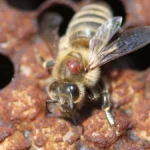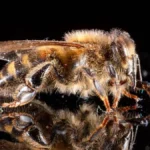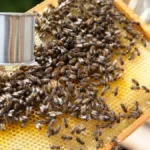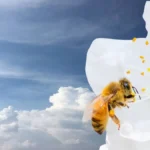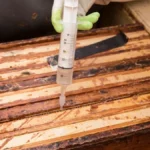The use of grease patties for bees to control various hive diseases and pests is widespread. In this article, we take a look at what you can use grease patties for bees to treat.
Grease patties for bees in their simplest form are just some sort of hard fat, such as vegetable shortening, with sugar mixed into them. When bees collect the sugar, they get covered in fat. We can therefore also add medicines to the grease patties for bees so that we can deliver these medications in the grease.
Tracheal Mite Grease Patties
The Simplest Grease patty – for treating Tracheal mite uses sugar to attract bees to the patty. The bees then burrow around in the fat and get covered in it. This in turn results in the bees getting a thin coat of fat on the exoskeleton.
Tracheal mites infect young bees and then multiply in their respiratory system. There is little point in a mite infecting an old bee and then trying to breed in the bee just as it dies. When a young bee hatches, she has a very fresh coat of non-rancid oils and waxes on her exoskeleton. A tracheal mite that has bred inside another bee will leave that bee and wave its feet around. If it touches a bee with a fresh nice coat of oil it will know that this is a young bee and will jump onto that bee and parasitize it.
Vegetable shortening such as Crisco or similar products has a mixture of oils that makes a bee smell old. Hence covering all the bees in the hive with vegetable shortening has the effect of frustrating the mites – they cannot find young bees to parasitize. The mites wave their little feet around and find no host and die eventually. This is a good thing.
Recipe For Tracheal Mite Patties
A simple recipe is as follows:
2 parts Crisco Vegetable Shortening (or similar product)
3 parts granular white sugar
1 part sugar syrup (make this by dissolving two parts sugar in one part hot water).
Mix the whole lot up in a bucket or tub and ensure it has an even texture. I then take a burger patty press and stamp the patties out. These presses require that you put a wax sheet in the press on each side. This is ideal as after pressing your patty, you can remove it and place it on a tray and freeze it. Once the patties have been frozen, you can put heaps of them in bags and take them to the apiary in a cooler box.
To administer the patty/patties, you place your grease patty just over the brood nest. The bees will get themselves all greased up in a matter of hours.

Antibiotic Grease Patties
For many years, Terramycin grease patties, or so-called extender patties were the first line of defense against American Foul Brood (AFB) – a bacterial disease that kills hives. The abuse and misuse of antibiotics is a global problem – and in bees, this is no different.
Treating bees with antibiotics requires the appropriate dose of antibiotics to be delivered to each bee. The extender patties provided such an erratic dose that in many cases there was not enough antibiotic to kill AFB.
If you provide a sub-lethal dose of antibiotic you create conditions for antibiotic resistance to evolve in the target. This happened and now the antibiotics do not work very well anymore.
I will not even go into how to make these patties as they should be discouraged. AFB infected hives should be destroyed if your bees are susceptible to this disease.
Read more about Nosema Treatment For Bees
Essential Oil Patties For Varroa
I have spoken to various beekeepers who use different mixes of essential oils in their grease patties for bees to achieve a level of varroa and tracheal mite control. It is possible to include up to 25% by weight thymol.
I do personally feel that tinkering with homemade solutions to major pests can be risky, and would probably suggest just buying a professionally formulated product such as Apigard. I learned this the hard way trying to fumigate my hives in the early days of varroa and did more damage to the hives than varroa did.
Essential oils may be naturally occurring compounds, but this does not mean they are not poisonous. Snakes are also naturally occurring and can be quite toxic.
Beware Of Dogs
Just an aside – I used to have my loyal bee dog Titan who went everywhere with me. Once when I was placing patties in hives I remember looking in the cooler box and thinking “I’m sure I had more patties in here.” Each time I would come back and fetch patties, Titan would then flip the lid open a bit when I was walking back to the apiary. He was eating the patties. Wax paper and all.
We had a long drive back, on a bumpy farm road. About twenty miles into the drive I remember hearing the dog whine and then hearing the most explosive release of dog poop. Titan had developed bee grease pattie diarrhea. This is just a very very bad thing. Getting that mixture out of the pickup seat took at least three steam cleanings and it never ever smelt fresh again.
I hope this article has helped you work out how to make bee patties for your bees. The method using the little hamburger patty press and wax paper makes the whole process very simple quick and easy. Remember to remove the top wax sheet when you place the patty in the hive. If you enjoyed this article, please share! And remember to keep dogs away from your bee patties!!
Beekeeper Grease Patties FAQ
What are grease patties for bees?
Grease patties are a mixture of fat (like vegetable shortening) and sugar, sometimes combined with medications or essential oils, used to treat and control hive pests such as tracheal mites and varroa mites.
How do grease patties work against tracheal mites?
The fat in grease patties coats the bees, making them less attractive to tracheal mites. The mites rely on detecting young bees by the fresh oils on their exoskeletons, and the fat masks this scent, reducing the mite infestation.
What ingredients are commonly used in grease patties?
Grease patties typically contain vegetable shortening (like Crisco), white sugar, and sometimes sugar syrup. Essential oils or medications may also be added depending on the type of pest being treated.
Can grease patties be used to control varroa mites?
Yes, some beekeepers use essential oils such as thymol in their grease patties to help control varroa mites, though caution is advised as improper formulations can harm the hive.
Are there any risks associated with using grease patties?
Yes, improper dosages of medications or essential oils in grease patties can harm bees. Additionally, extended or overuse may lead to resistance in pests or other health issues in bees.
How often should I replace grease patties in my hive?
Grease patties should typically be replaced every few weeks, especially during periods of heavy mite infestation or as part of regular hive maintenance.
Can I add antibiotics to beehive grease patties?
Antibiotics were once used in grease patties to treat diseases like American Foulbrood, but this practice is now discouraged due to the risk of antibiotic resistance. It’s recommended to avoid using antibiotics without professional guidance.
How do I make grease patties for tracheal mites?
A basic recipe includes 2 parts vegetable shortening, 3 parts granulated sugar, and 1 part sugar syrup. Mix well, shape into patties, and place them above the brood nest in your hive.
Can grease patties be frozen for later use?
Yes, grease patties can be pressed into shape, frozen, and stored for later use. Freezing allows beekeepers to prepare large batches and use them as needed.
Do grease patties attract animals or pests other than bees?
Yes, animals such as dogs may be attracted to the grease patties due to their fat content. It’s important to store them securely and avoid leaving them unattended where animals might access them.

Dr. Garth A. Cambray is a Canadian/South African entrepreneur and beekeeper with 28 years of experience in apiculture and specializes in adding value to honey. His Ph.D. research developed a new advanced continuous fermentation method for making mead that has resulted in a number of companies globally being able to access markets for mead. His company, Makana Meadery, exports honey mead to the USA where it is available to discerning connoisseurs. He has also developed technologies to commercially manufacture organic honey vinegar in Zambia for export globally. He holds a few patents globally in the ethanol industry and believes in technology and knowledge transfer for human development and environmental sustainability. One of his proudest achievements is the fact that the wind farm he started at one of his old apiary sites has essentially made his hometown carbon neutral.

